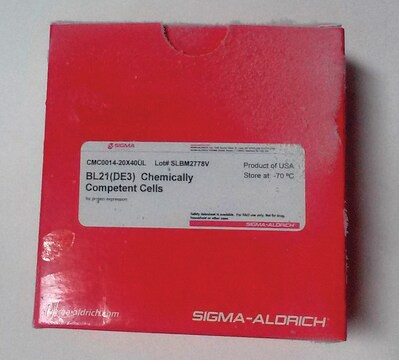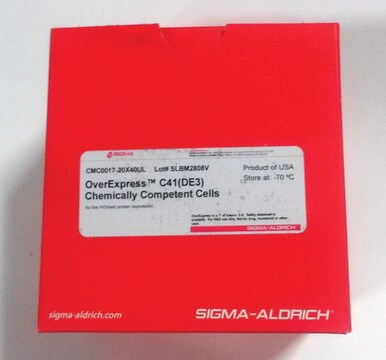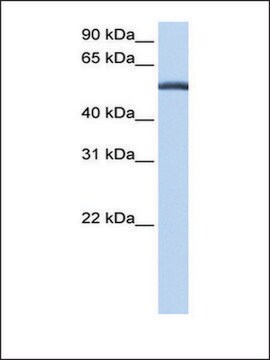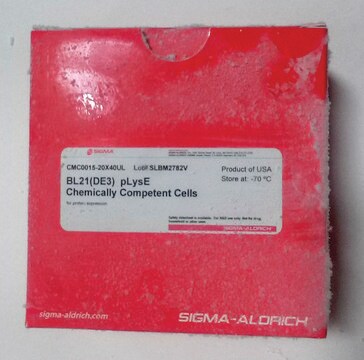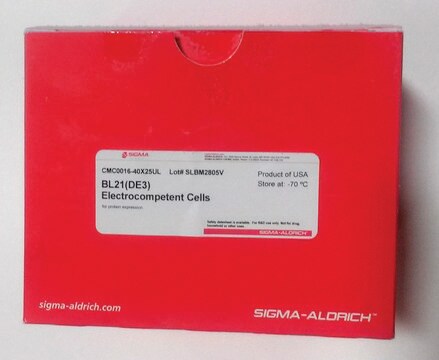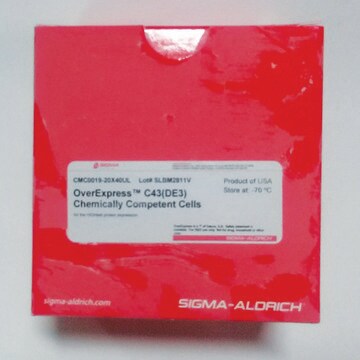CMC0014
BL21(DE3) Chemically Competent Cells
Escherichia coli, rod shaped
Synonym(s):
Competent E. coli cells
Sign Into View Organizational & Contract Pricing
All Photos(3)
About This Item
UNSPSC Code:
41106202
NACRES:
NA.85
biological source:
Escherichia coli
growth mode:
adherent or suspension
morphology:
rod shaped
Recommended Products
Product Name
BL21(DE3) Chemically Competent Cells, for protein expression
biological source
Escherichia coli
grade
for molecular biology
growth mode
adherent or suspension
morphology
rod shaped
technique(s)
microbiological culture: suitable
cell transformation
competent cell type: chemically competent
transformation efficiency: ≥1 x 107 cfu/μg
shipped in
dry ice
storage temp.
−70°C
General description
The BL21(DE3) Chemically Competent strains contain the phage T7 RNA polymerase gene linked to the IPTG-inducible promoter, for use with any expression plasmid containing the T7 promoter.
Genotype
F – ompT hsdSB (rB- mB-) gal dcm (DE3)
Genotype
F – ompT hsdSB (rB- mB-) gal dcm (DE3)
Application
The E. coli strain BL21 (DE3) has been used:
- to express tau 2N4R isoform (aa1–441) and the truncated tau (aa1–421) using pET19b as expression vector.
- BL21(DE3)Chemically Competent Cells has been used for the transformation and expressionof protegrin-1 (PG1) peptides.
- to express 6His-TEVsite-Hs ARF1 (17-181)-Q71L in pHis2 vector.
Features and Benefits
- a transformation efficiency of >1 × 107 cfu/μg.
- economical prices
- offering superior value for everyday protein expression work.
Components
- BL21(DE3) chemically competent cells
- pUC 19 transformation control DNA
- recovery medium for expression
related product
Product No.
Description
Pricing
Storage Class Code
10 - Combustible liquids
Choose from one of the most recent versions:
Already Own This Product?
Find documentation for the products that you have recently purchased in the Document Library.
Customers Also Viewed
Yasaman Damestani et al.
Lasers in surgery and medicine, 48(8), 782-789 (2016-10-19)
The development and feasibility of a novel nanocrystalline yttria-stabilized-zirconia (nc-YSZ) cranial implant has been recently established. The purpose of what we now call "window to the brain (WttB)" implant (or platform), is to improve patient care by providing a technique
A validated antibody panel for the characterization of tau post-translational modifications.
Ebru E, et al.
Mol. Neurodegener., 12(1), 87-87 (2017)
Romana Koszagova et al.
Microbial cell factories, 17(1), 139-139 (2018-09-05)
Physiological aggregation of a recombinant enzyme into enzymatically active inclusion bodies could be an excellent strategy to obtain immobilized enzymes for industrial biotransformation processes. However, it is not convenient to recycle "gelatinous masses" of protein inclusion bodies from one reaction
David B Sauer et al.
eLife, 9 (2020-09-02)
Citrate, α-ketoglutarate and succinate are TCA cycle intermediates that also play essential roles in metabolic signaling and cellular regulation. These di- and tricarboxylates are imported into the cell by the divalent anion sodium symporter (DASS) family of plasma membrane transporters
Gints Kalnins et al.
Nature communications, 11(1), 388-388 (2020-01-22)
Bacterial microcompartments (BMCs) are prokaryotic organelles consisting of a protein shell and an encapsulated enzymatic core. BMCs are involved in several biochemical processes, such as choline, glycerol and ethanolamine degradation and carbon fixation. Since non-native enzymes can also be encapsulated
Our team of scientists has experience in all areas of research including Life Science, Material Science, Chemical Synthesis, Chromatography, Analytical and many others.
Contact Technical Service
